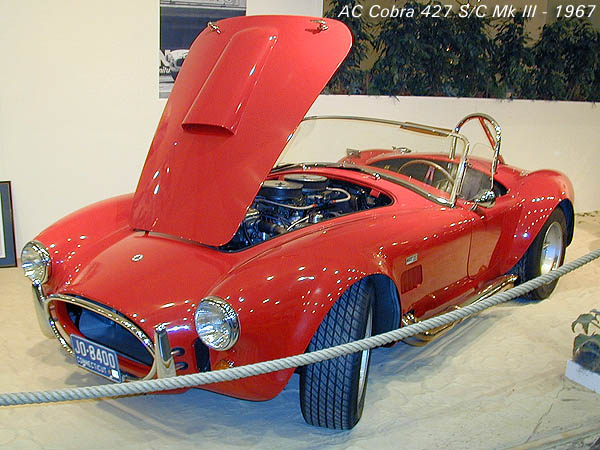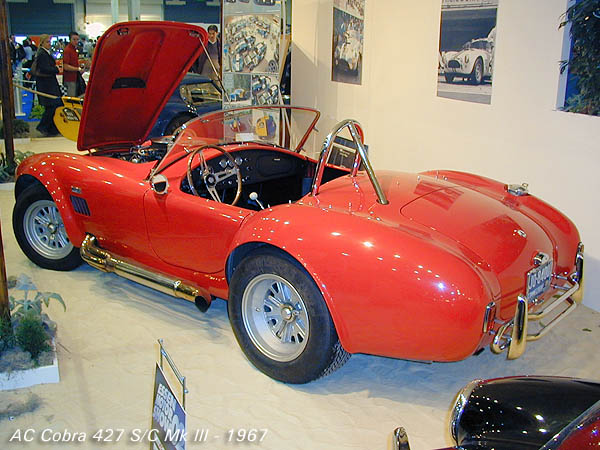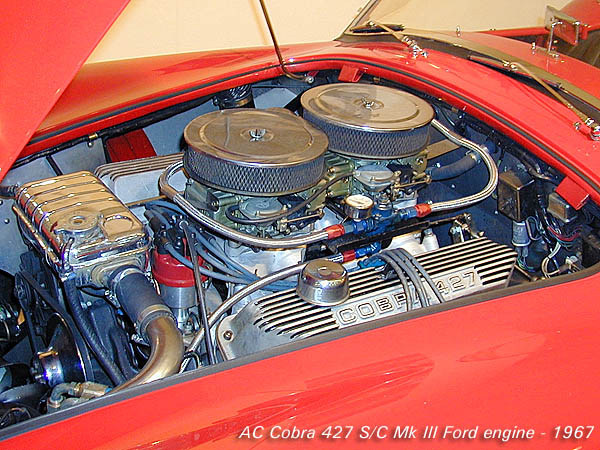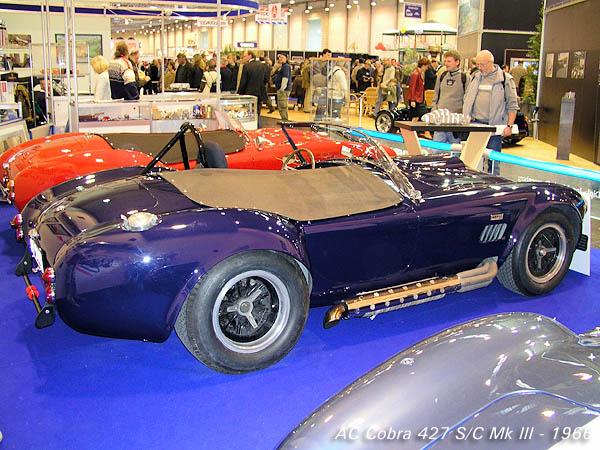|
 ...and that was accomplished by yet another engine upgrade for the Cobra, in order to boost its speed and competitiveness in racing. Shelby's much quoted motto was "there's no substitute for cubic inches" and following that philosophy a big 427 ci (6997 cc) V8 was shoehorned into the Cobra Mk II chassis in March 1964. This engine was usually found in the large Ford Galaxie racing saloons and proved quite a handful in the nimble Cobra prototype driven by Ken Miles at the Sebring race. Its potential however was impressive and so Shelby decided to turn it into a production version. ...and that was accomplished by yet another engine upgrade for the Cobra, in order to boost its speed and competitiveness in racing. Shelby's much quoted motto was "there's no substitute for cubic inches" and following that philosophy a big 427 ci (6997 cc) V8 was shoehorned into the Cobra Mk II chassis in March 1964. This engine was usually found in the large Ford Galaxie racing saloons and proved quite a handful in the nimble Cobra prototype driven by Ken Miles at the Sebring race. Its potential however was impressive and so Shelby decided to turn it into a production version.
During the rest of 1964 the new Cobra 427 was further developed; quite a number of substantial changes to the original concept were needed to realize its potential and to cope with the brute power of the big block engine.
 Most notable of the Cobra's third incarnation was the complete redesign of its chassis and suspension. With the help from Ford's engineers and computers, fronted by Klaus Arning, a new tubular chassis was constructed from stronger 4 inch (10.16 cm) tubes (the previous Cobras had a chassis from 3 inch (7.62 cm) tubes) and fitted with a coil spring suspension (replacing the outdated leaf spring system). Remarkably the new suspension design was based on the suspension system John Tojeiro had used for his AC Ace prototype more than 10 years before! The tubes of the chassis were set 2.5 inch (6.35 cm) wider apart to make room for the larger engine and the coil spring suspension was complemented with upper and lower wishbones and very wide tires to ensure sufficient traction. Most notable of the Cobra's third incarnation was the complete redesign of its chassis and suspension. With the help from Ford's engineers and computers, fronted by Klaus Arning, a new tubular chassis was constructed from stronger 4 inch (10.16 cm) tubes (the previous Cobras had a chassis from 3 inch (7.62 cm) tubes) and fitted with a coil spring suspension (replacing the outdated leaf spring system). Remarkably the new suspension design was based on the suspension system John Tojeiro had used for his AC Ace prototype more than 10 years before! The tubes of the chassis were set 2.5 inch (6.35 cm) wider apart to make room for the larger engine and the coil spring suspension was complemented with upper and lower wishbones and very wide tires to ensure sufficient traction.
Also the Cobra's exterior was revised. The body became 8 inch (20.32 cm) wider and was fitted with distinctively protruding wheelarches to cover the big wheels. An added hood scoop indicated its powerful engine. With all these modifications the Cobra looked even more butch and aggressive than it had done before and had assumed its ultimate form.
 The new Cobra 427, also referred to as the Mk III or coil spring Cobra, was introduced to the public at the Riverside International Raceway in January 1965. Production only started in April 1965 at AC Cars in Britain and so the goal to build 100 racing versions of this Cobra in order to be certified by the FIA for international production car racing couldn't be met. This caused Ford to concentrate its racing effort on the GT40 programme and not to enter Mk III Cobras in racing under the factory banner. The new Cobra 427, also referred to as the Mk III or coil spring Cobra, was introduced to the public at the Riverside International Raceway in January 1965. Production only started in April 1965 at AC Cars in Britain and so the goal to build 100 racing versions of this Cobra in order to be certified by the FIA for international production car racing couldn't be met. This caused Ford to concentrate its racing effort on the GT40 programme and not to enter Mk III Cobras in racing under the factory banner.
Because of that Shelby found himself stuck with 34 Mk III Cobras built for competition in production car racing. For a few months these unpainted cars were languishing outside the Shelby factory until a visiting sales representative suggested selling them as "semi-competition" road cars. This way the barely street legal Cobra 427 S/C was born, marketed as the fasted production car available. Only 31 were made, the other 3 were sold as full competition racing cars.
Still, the regular Cobra 427 roadster was hardly less impressive. It accelerated from 0 to 60 mph (96 kph) in 4.3 seconds, from 0 to 100 mph (161 kph) in 8.8 seconds and had a maximum speed of 165 mph (265 kph). This top speed was somewhat tempered by the Cobra's increased weight (to 1100 kg) and relatively high drag.
 Fitted with the Ford 427 ci engine the Cobra had a staggering 425 hp @ 6000 rpm at its disposal, not to mention an earth moving torque of 650 Nm @ 3700 rpm. The S/C version did even better at 520 hp @ 6500 rpm. But not all Cobras 427 were actually fitted with the 427 ci performance engine. Due to cost and availability concerns many of the road going versions of the Cobra 427 were fitted with the cheaper and less powerful Ford 428 ci (7014 cc) V8 engine in "Police Interceptor" trim. This engine provided the Cobra with 340 hp @ 5400 rpm and brought the top speed down to about 140 mph (225 kph) with 0-60 acceleration in 4.8 seconds and 0-100 in 11.7 seconds. It was quite a bit heavier as well at 1311 kg. Still, most customers didn't notice the difference since getting the maximum performance out of the car was only reserved for the experts; regular drivers had a hard enough time keeping the car on the road. Fitted with the Ford 427 ci engine the Cobra had a staggering 425 hp @ 6000 rpm at its disposal, not to mention an earth moving torque of 650 Nm @ 3700 rpm. The S/C version did even better at 520 hp @ 6500 rpm. But not all Cobras 427 were actually fitted with the 427 ci performance engine. Due to cost and availability concerns many of the road going versions of the Cobra 427 were fitted with the cheaper and less powerful Ford 428 ci (7014 cc) V8 engine in "Police Interceptor" trim. This engine provided the Cobra with 340 hp @ 5400 rpm and brought the top speed down to about 140 mph (225 kph) with 0-60 acceleration in 4.8 seconds and 0-100 in 11.7 seconds. It was quite a bit heavier as well at 1311 kg. Still, most customers didn't notice the difference since getting the maximum performance out of the car was only reserved for the experts; regular drivers had a hard enough time keeping the car on the road.
That aspect of the Cobra 427 and the fact that its concept was aging rapidly also implied its doom: the last Shelby Cobra 427 left the factory in 1967 after only 348 of them were built. This was the end of the original Cobra in the US.
The Shelby name continued on the Mustangs and with the demise of the Cobra in 1967 the Shelby Mustang GT-500 was introduced, powered by the 428 ci V8 previously appearing in the Cobra 427 under false banner. Also the Sunbeam Tiger was upgraded in 1967: its 260 ci block was replaced by the 289 ci unit once propelling in the Cobra Mk II and which was also used in the Shelby Mustang GT-350 up to the 1968 model year, more or less completing Shelby's hand-me-down system.
|
